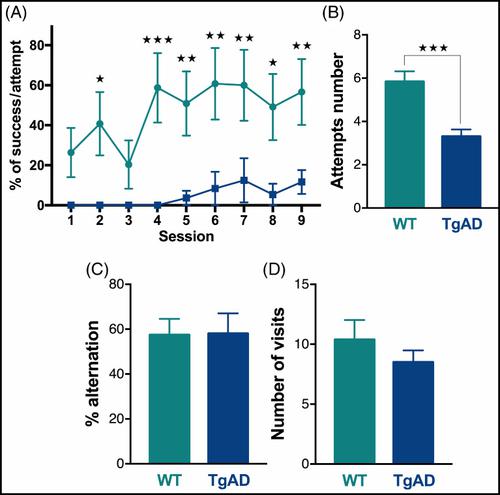当前位置:
X-MOL 学术
›
Genes Brain Behav.
›
论文详情
Our official English website, www.x-mol.net, welcomes your
feedback! (Note: you will need to create a separate account there.)
Spatial reference learning deficits in absence of dysfunctional working memory in the TgF344-AD rat model of Alzheimer's disease
Genes, Brain and Behavior ( IF 2.4 ) Pub Date : 2020-11-05 , DOI: 10.1111/gbb.12712 Benjamin B Tournier 1, 2 , Cristina Barca 1 , Aïda B Fall 1 , Yesica Gloria 1 , Léa Meyer 1 , Kelly Ceyzériat 1, 3, 4 , Philippe Millet 1, 2
Genes, Brain and Behavior ( IF 2.4 ) Pub Date : 2020-11-05 , DOI: 10.1111/gbb.12712 Benjamin B Tournier 1, 2 , Cristina Barca 1 , Aïda B Fall 1 , Yesica Gloria 1 , Léa Meyer 1 , Kelly Ceyzériat 1, 3, 4 , Philippe Millet 1, 2
Affiliation

|
Alzheimer's disease (AD) is characterized by cognitive disorders and alterations of behavioral traits such as anhedonia and anxiety. Contribution of nonphysiological forms of amyloid and tau peptides to the onset of neurological dysfunctions remains unclear because most preclinical models only present one of those pathological AD-related biomarkers. A more recently developed model, the TgF344-AD rat has the advantage of overexpressing amyloid and naturally developing tauopathy, thus making it close to human familial forms of AD. We showed the presence of a learning dysfunction in a reference memory test, without spatial working memory impairment but with an increase in anxiety levels and a decrease in motivation to participate in the test. In the sucrose preference test, TgF344-AD rats did not show signs of anhedonia but did not increase the volume of liquid consumed when the water was replaced by sucrose solution. These behavioral phenomena were observed at an age when tau accumulation are absent, and where amyloid deposits are predominant in the hippocampus and the entorhinal cortex. Within the hippocampus itself, amyloid accumulation is heterogenous between the subiculum, the dorsal hippocampus and the ventral hippocampus. Thus, our data demonstrated heterogeneity in the appearance of various behavioral and neurochemical markers in the TgF344-AD rat. This multivariate analysis will therefore make it possible to define the stage of the pathology, to measure its evolution and the effects of future therapeutic treatments.
中文翻译:

阿尔茨海默病 TgF344-AD 大鼠模型中没有功能失调工作记忆的空间参考学习缺陷
阿尔茨海默病 (AD) 的特征是认知障碍和行为特征的改变,例如快感缺失和焦虑。淀粉样蛋白和 tau 肽的非生理形式对神经功能障碍发作的贡献仍不清楚,因为大多数临床前模型仅呈现这些病理性 AD 相关生物标志物之一。最近开发的模型,TgF344-AD 大鼠具有过度表达淀粉样蛋白和自然发展 tau 病变的优势,因此使其接近人类家族性 AD。我们在参考记忆测试中显示存在学习功能障碍,没有空间工作记忆障碍,但焦虑水平增加,参与测试的动机降低。在蔗糖偏好测试中,TgF344-AD 大鼠没有表现出快感缺乏的迹象,但当用水被蔗糖溶液代替时,消耗的液体量没有增加。这些行为现象是在 tau 蛋白积累不存在的年龄观察到的,并且淀粉样蛋白沉积物在海马和内嗅皮质中占主导地位。在海马体内部,下托、背侧海马体和腹侧海马体之间的淀粉样蛋白积累是异质的。因此,我们的数据证明了 TgF344-AD 大鼠中各种行为和神经化学标志物的出现异质性。因此,这种多变量分析将使定义病理学阶段、测量其演变和未来治疗的效果成为可能。这些行为现象是在 tau 蛋白积累不存在的年龄观察到的,并且淀粉样蛋白沉积物在海马和内嗅皮质中占主导地位。在海马体内部,下托、背侧海马体和腹侧海马体之间的淀粉样蛋白积累是异质的。因此,我们的数据证明了 TgF344-AD 大鼠中各种行为和神经化学标志物的出现异质性。因此,这种多变量分析将使定义病理学阶段、测量其演变和未来治疗的效果成为可能。这些行为现象是在 tau 蛋白积累不存在的年龄观察到的,并且淀粉样蛋白沉积物在海马和内嗅皮质中占主导地位。在海马体内部,下托、背侧海马体和腹侧海马体之间的淀粉样蛋白积累是异质的。因此,我们的数据证明了 TgF344-AD 大鼠中各种行为和神经化学标志物的出现异质性。因此,这种多变量分析将使定义病理学阶段、测量其演变和未来治疗的效果成为可能。下托、背侧海马和腹侧海马之间的淀粉样蛋白积累是异质的。因此,我们的数据证明了 TgF344-AD 大鼠中各种行为和神经化学标志物的出现异质性。因此,这种多变量分析将使定义病理学阶段、测量其演变和未来治疗的效果成为可能。下托、背侧海马和腹侧海马之间的淀粉样蛋白积累是异质的。因此,我们的数据证明了 TgF344-AD 大鼠中各种行为和神经化学标志物的出现异质性。因此,这种多变量分析将使定义病理学阶段、测量其演变和未来治疗的效果成为可能。
更新日期:2020-11-05
中文翻译:

阿尔茨海默病 TgF344-AD 大鼠模型中没有功能失调工作记忆的空间参考学习缺陷
阿尔茨海默病 (AD) 的特征是认知障碍和行为特征的改变,例如快感缺失和焦虑。淀粉样蛋白和 tau 肽的非生理形式对神经功能障碍发作的贡献仍不清楚,因为大多数临床前模型仅呈现这些病理性 AD 相关生物标志物之一。最近开发的模型,TgF344-AD 大鼠具有过度表达淀粉样蛋白和自然发展 tau 病变的优势,因此使其接近人类家族性 AD。我们在参考记忆测试中显示存在学习功能障碍,没有空间工作记忆障碍,但焦虑水平增加,参与测试的动机降低。在蔗糖偏好测试中,TgF344-AD 大鼠没有表现出快感缺乏的迹象,但当用水被蔗糖溶液代替时,消耗的液体量没有增加。这些行为现象是在 tau 蛋白积累不存在的年龄观察到的,并且淀粉样蛋白沉积物在海马和内嗅皮质中占主导地位。在海马体内部,下托、背侧海马体和腹侧海马体之间的淀粉样蛋白积累是异质的。因此,我们的数据证明了 TgF344-AD 大鼠中各种行为和神经化学标志物的出现异质性。因此,这种多变量分析将使定义病理学阶段、测量其演变和未来治疗的效果成为可能。这些行为现象是在 tau 蛋白积累不存在的年龄观察到的,并且淀粉样蛋白沉积物在海马和内嗅皮质中占主导地位。在海马体内部,下托、背侧海马体和腹侧海马体之间的淀粉样蛋白积累是异质的。因此,我们的数据证明了 TgF344-AD 大鼠中各种行为和神经化学标志物的出现异质性。因此,这种多变量分析将使定义病理学阶段、测量其演变和未来治疗的效果成为可能。这些行为现象是在 tau 蛋白积累不存在的年龄观察到的,并且淀粉样蛋白沉积物在海马和内嗅皮质中占主导地位。在海马体内部,下托、背侧海马体和腹侧海马体之间的淀粉样蛋白积累是异质的。因此,我们的数据证明了 TgF344-AD 大鼠中各种行为和神经化学标志物的出现异质性。因此,这种多变量分析将使定义病理学阶段、测量其演变和未来治疗的效果成为可能。下托、背侧海马和腹侧海马之间的淀粉样蛋白积累是异质的。因此,我们的数据证明了 TgF344-AD 大鼠中各种行为和神经化学标志物的出现异质性。因此,这种多变量分析将使定义病理学阶段、测量其演变和未来治疗的效果成为可能。下托、背侧海马和腹侧海马之间的淀粉样蛋白积累是异质的。因此,我们的数据证明了 TgF344-AD 大鼠中各种行为和神经化学标志物的出现异质性。因此,这种多变量分析将使定义病理学阶段、测量其演变和未来治疗的效果成为可能。











































 京公网安备 11010802027423号
京公网安备 11010802027423号